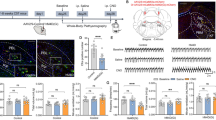Abstract
In this study, the effects of axotomy on heat shock protein 70 (hsp70) mRNA levels were analyzed by northern blot hybridization with a mouse-inducible hsp70 cDNA probe. The right facial nerve of adult golden hamsters was axotomized external to the skull, with the left nerve serving as sham-operated and internal control. Postoperative survival times were 0.5, 2, 6, 12, and 24 hr, with three to six animals per time point. Total RNA in the axotomized and control facial nuclear groups, dissected from the brain stem, was isolated by guanidinium-thiocyanate extraction and analyzed by northern hybridization and scanning densitometry. For normalization, the blots were rehybridized with a genomic cDNA probe complementary to the 28 S rRNA. At 0.5 hr postoperative, there was a 68% induction of hsp70 mRNA levels as compared to control. This increase peaked at 2 hr postoperative with a 280% induction and declined subsequently to 160% at 6 hr, 33% at 12 hr, and — 56% at 24 hr, relative to control levels. As a positive control, hyperthermia-induced hsp70 expression was established in hamster whole brain using northern blot hybridization and the mouse-inducible hsp70 cDNA probe. There was a 126% increase in hsp70 mRNA levels relative to control at 1.5 hr following hyperthermia. By 6.5 hr after the 1.5-hr hyperthermic period, there was a 40% decrease in hsp70 mRNA levels below control. The results provide the first evidence that peripheral axotomy acts as a cell stressor to induce the expression of hsp70 mRNA. Within our current understanding of the nerve cell body response to injury, the data represent the earliest changes in gene expression following axotomy reported thus far.
Similar content being viewed by others
References
Ausubel, F. M., Brent, R., Kingston, R. E., Moore, D. D., Seidman, J. S., Smith, J. A., and Struhl, K. (1989).Current Protocols in Molecular Biology, Greene and Wiley-Interscience, New York, sections 4.9.1–4.9.8.
Barbe, M. F., Tytell, M., Gower, D. J., and Welch, W. J. (1988). Hyperthermia protects against light damage in the rat retina.Science 241:1817–1820.
Brown, I. R., Heikkila, J. J., and Cosgrove, J. W. (1982). Analysis of protein synthesis in the mammalian brain using LSD and hyperthermia as experimental probes. In Brown, I. R. (ed),Molecular Approaches to Neurobiology, Academic Press, New York, pp. 221–253.
Brown, I. R., Lowe, D. G., and Moran, L. A. (1985). Expression of heat shock genes in fetal and maternal rabbit brain.Neurochem. Res. 10:1277–1284.
Brown, I. R., Rush, S., and Ivy, G. O. (1989). Induction of a heat shock gene at the site of tissue injury in the rat brain.Neuron 2:1559–1564.
Chikaraishi, D. M., Buchannan, L., Danna, K. J., and Harrington, C. A. (1983). Genomic organization of rat rDNA.Nucleic Acids Res. 11:6437–6452.
Chomczynski, P., and Sacchi, N. (1987). Single-step method of RNA isolation by acid guanidinium thiocyanate-phenol-chloroform extraction.Anal. Biochem. 162:156–159.
Clark, B. D., and Brown, I. R. (1986). Induction of a heat shock protein in the isolated mammalian retina.Neurochem. Res. 11:269–319.
Gower, D. J., Hollman, C., Lee, K. S., and Tytell, M. (1989). Spinal cord injury and the stress protein response.J. Neurosurg. 70, 605–611.
Jones, K. J., and LaVelle, A. (1986). Differential effects of axotomy on immature and mature hamster facial motor neurons: A time course study of the initial nucleolar and nuclear changes.J. Neurocytol. 15:197–206.
LaVelle, A., and LaVelle, F. W. (1984). Neuronal reaction to injury during development. In Almi, C. R., and Finger, S. (eds.),Developmental Neurobiology, Academic Press, New York, pp. 3–16.
Lindquist, S. (1986). The heat-shock response.Annu. Rev. Biochem. 55:1151–1191.
Moran, L. A., Chauvin, M., Kennedy, M. E., Korri, M., Lowe, D. G., Nicholoson, R. C., and Perry, M. D. (1983). The major heat-shock protein gene family: Related sequences in mouse, Drosophila, and yeast.Can. J. Biochem. Cell Biol. 61:488–499.
Nover, L. (1984).Heat Shock Responses of Eukaryotic Cells, Springer-Verlag, New York.
Nowak, T. S. (1985). Synthesis of a stress protein following transient ischemia in the gerbil.J. Neurochem. 45:1635–1641.
O'Malley, K., Mauron, A., Barchas, J. D., and Kedes, L. (1985). Constitutively expresed rat mRNA encoding a 70-kilodalton heat-shock like protein.Mol. Cell. Biol. 5:3476–3483.
Ritossa, F. M. (1962). A new puffing pattern induced by heat shock and DNP in Drosophila.Experientia 18:571–573.
Sprang, G. K., and Brown, I. R. (1987). Selective induction of a heat shock gene in fibre tracts and cerebellar neurons of the rabbit brain detected byin situ hybridization.Mol. Brain Res. 3:89–93.
Vass, K., Berger, M. L., Nowak, T. S., Jr., Welch, W. J., and Lassmann, H. (1989). Induction of stress protein HSP70 in nerve cells after status epilepticus in the rat.Neurosci. Lett. 100:259–264.
Wu, B., Hunt, C., and Morimoto, R. (1985). Structure and expression of the human gene encoding major heat shock protein hsp70.Mol. Cell. Biol. 5:330–341.
Author information
Authors and Affiliations
Rights and permissions
About this article
Cite this article
New, G.A., Hendrickson, B.R. & Jones, K.J. Induction of heat shock protein 70 mRNA in adult hamster facial nuclear groups following axotomy of the facial nerve. Metab Brain Dis 4, 273–279 (1989). https://doi.org/10.1007/BF00999773
Received:
Accepted:
Issue Date:
DOI: https://doi.org/10.1007/BF00999773




